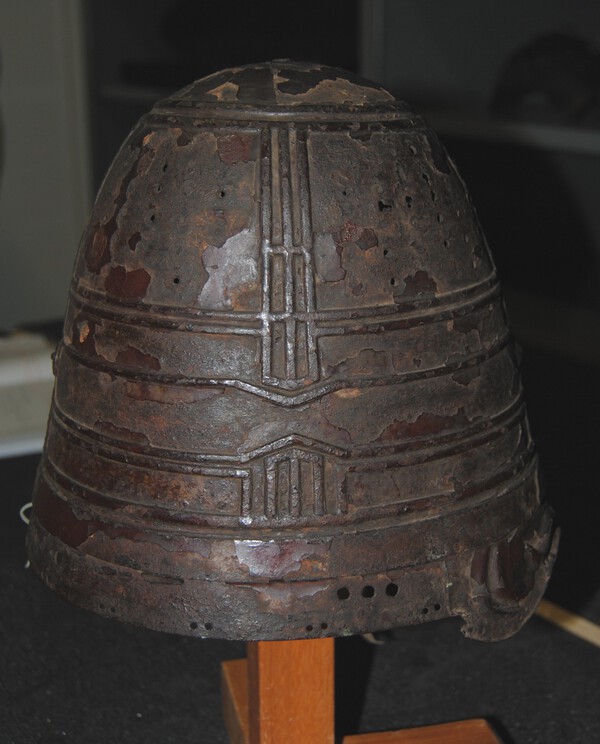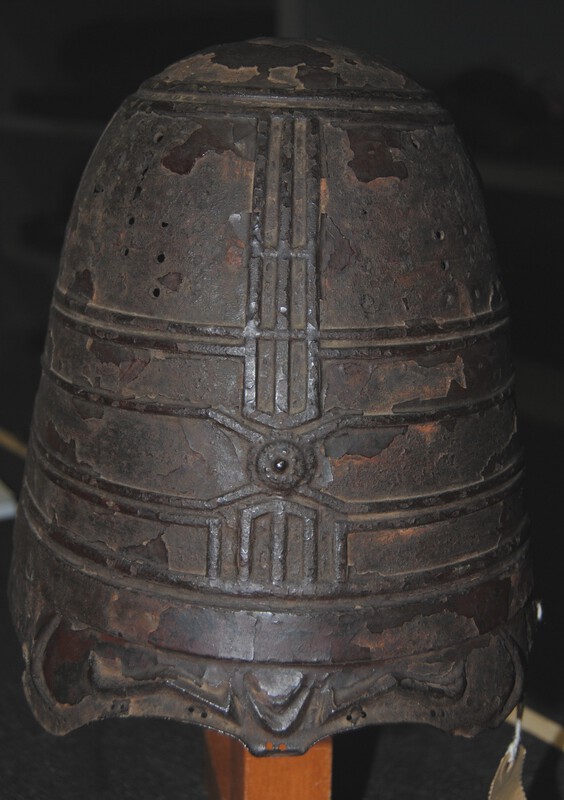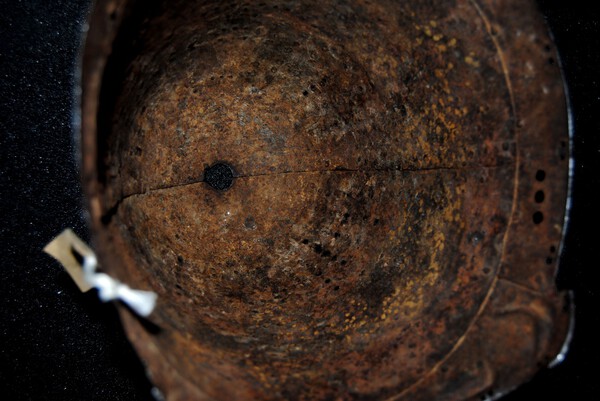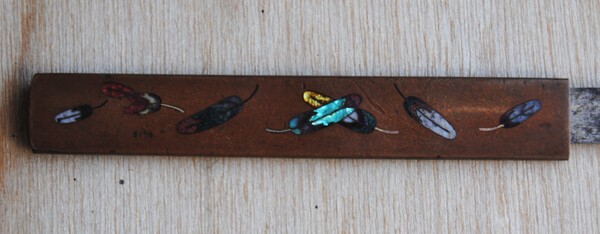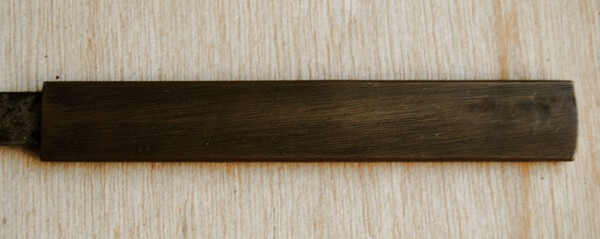
IanB
Members-
Posts
1,778 -
Joined
-
Last visited
-
Days Won
23
Everything posted by IanB
-
A dealer in Nottingham, the real one in England, had a daisho done with malachite saya. He is now dead but about 5 years ago I saw it in the hands of his relative who had taken over the business. Ian Bottomley
-
Anders, This helmet bowl was indeed on Yahoo Auctions Japan. To determine the shape the one view needed is the one you haven't provided - a side view. Ian Bottomley
-
Jan, It is 'old period match' (for a matchlock gun) Ian Bottomley
-
My first reaction on seeing this tsuba was that the kamon represent a wide ranged of families amongst which I can recognise the Shimazu, Takeda, Ii, Matsudaira, Honda without getting the books out. The large Tokugawa kamon in the centre suggests this didn't start out as a tsuba, but was originally some other decorative item. Note how it has been modified by cutting the background away to leave the kamon in relief - this is very badly done where they are not circular or where two overlap. This is very obvious with the Honda kamon at 11.00 o'clock. I would suggest this was done so that the background could be enamelled to enhance it when it was made into a tsuba. I don't think it was done in the Meiji period as a 'Hamamono' - the sekigane and general abuse of the seppa dai both suggest it has been on a couple of swords at least. I am also intrigued by the hole at 6.00 o'clock. Perhaps that is the clue to its original purpose. Ian Bottomley
-
Eric, These are not unknown. Some have just one horizontal plate with 3 or 4 'mini gessan' attached by mail or lacing hanging below. This looks an old bowl with a much newer peak and shikoro. Don't like the fact that the legs of the rivets show on top. Ian Bottomley
-
Piers, I'm not sure about back copies, it was a while ago. If you do call on us Northerners I will get the library staff to run off a copy. As for the date of these guns - help!!! Indian material often has the appearance of great antiquity even if relatively new. The monsoons and other climatic factors ravage iron artefacts. MY guess, and it is only that, would be 18th - 19th century. We have a load of material taken from Lahore in the 1850's that look like new, that left in Lahore looks, I am told, ancient. Ian B
-
Eric, Please excuse my interfering, but the stirrup leathers of the displayed saddle are running wrongly. They should be threaded through the slot in the fore and aft part of the saddle tree, as they are, and through the small pad that covers the bindings between the two igi, then both ends go straight down to the buckle of the stirrup. The loop of leather on the inner pad of the saddle is for the girth whose ends come up from under the horse's belly, through that loop of leather and then between the two pads to emerge through the holes at the top of the outer pad. What you do then depends on the type of girth. If it is a traditional one, made of a strip of cloth, the ends are brought forward and tied off either around the pommel or in front of it. If it is an Edo period girth, of hemp strings with an iron ring on one end and two cords on the other, the ring is positioned just out of the hole on the right and the two cords passed under the tree and tied to the ring. This tying of the girth on top rather than under the horse's belly was why the generals at the Battle of Uji river could adjust his girth in mid-stream. Ian Bottomley
-
Piers, The gun is Indian and nothing to do with the Portuguese. The shape of the stock suggests it originated in the region of Indore (see my article: A Tentative Classification of Indian Matchlock Guns; Royal Armouries Yearbook, Vol 7, 2002). There is a very similar gun in the Royal Armouries collection with the same conical shroud around the end of the revolving cylinder. Just what the purpose of the shroud is I am not sure. My initial thought was that it might prevent an accidental flash-over from chamber to chamber and direct the balls and flame forward, but the fit between the chambers and the shroud is the same as between the chambers and the barrel. A very similar gun, but without a shroud and also in the RA, was used by Colt as an example of an early revolver when he gave a lecture on his revolving pistols to the Institute of Civil Engineers in 1851. Ian Bottomley
-
Chris, I was in work today and should have photographed the pseudo naginata. I'm off on holiday next week but I will take some pics later. As for others, I once had the opportunity to buy one but was too ignorant at the time. There must be others about, if I put the pics up, I'm sure people will say 'Oh that is what it is'. Ian B
-
In the catalogue of the Danish Kunstkammer (Lundaek T N D, Ethnographic objects in the Royal Danish Kunstkammer 1650-1800) there are illustrations of several katana fitted with dha hilts. There are similar ones illustrated in the catalogue of the Hermitage Museum. These strange items have what seem to be standard katana blades and scabbards with kurigata, but with long (14" - 18" at a guess) black lacquered hilts that swell somewhat towards a rounded end. From memory I do not remember seeing any bindings or tsuba. Clearly these have a secondary origin in South East Asia, but whether the hilts are from that region, or from Japan, is difficult to say. There is also the matter of the imitation naginata. The Royal Armouries Museum has three of these weapons with what appear to be standard naginata blades mounted in black lacquered shafts. Itis there the resemblance ends. The shafts are round not oval, with sukashi tsuba of low grade shakudo in the form of multi petalled chrysanthemums. Below this is a section of metal tubes and rings, gilded and decorated with foliage. Whilst the blades look conventional, they have no real tang, just a short strip that is riveted into the shaft, and they are not hardened. I would suggest these items were specifically made for trade in SE Asia. Ian Bottomley
-
Eric, Kyubi no ita protects the bow arm and hence can be solid. The sendan no ita is for the sword arm and hence is articulated. Ian B
-
Eric, You are blessed with an ability to find the unusual. That set is fantastic. Ian Bottomley
-
Piers, I may have told this tale already, but I had a similar incident at Nikko for the Spring Festival. About 20 guys were dressed as archers with utsubo - they were fake but looked good. They insisted they were worn with the lid upwards diagonally across their backs. I suggested they might try wearing them properly and received strange pitying looks. This despite the fact that there are large murals done in the 20's showing them worn properly. Ian
-
Piers, With your command of Japanese surely not. Gyoyo were originally shoulder defences on early do-maru worn by retainers - sitting on the point of the shoulder like the kohire of later armours. When the samurai adopted do-maru they added the o-sode from their old o-yoroi so the gyoyo became redundant in their original role and were swung forward to cover the fastening cords. Far from being decorative, they protect what are the most important cords on the do. George, The date is that when the pattern of leather was licensed for production - Shohei period. Ian
-
Jan, I don't want to rain on your parade, but I'm afraid the Kyubi no ita isn't very old. The cross shapes are in fact shobu gawa - that is they are meant to be iris flowers with leaves each side. Traditionally this was made by clamping strips of wood with carved wooden stamps attached onto the leather wrapped around a drum. It was then dyed with indigo. Where the stamps pressed into the leather the dye was prevented from penetrating thus leaving the design in white on the blue ground. However, the dye did bleed under the stamp slightly giving the design a slightly fuzzy look. The leather on your kyubi no ita is too sharp and has been done with a stencil. I would guess Showa period. Ian Bottomley
-
Luc, I agree the helmet might be Saiga, but I would have expected the eyebrows to be riveted on rather than embossed if it were. It is annoying that we know so little about the people who made these wonderful helmets, but they seem to have been reluctant to add their signatures to anything that was not a regular helmet. It is the same with masks - some of which must have taken great skill and a lot of time to make yet are unsigned. Ian Bottomley
-
Socket (Fukuro) Yari from Showa22
IanB replied to Brian's topic in Auctions and Online Sales or Sellers
A very nice blade but a shame about the pole. Note the ring attached for hanging a label. This was originally a long shaft that has been cut down - tragic. Ian Bottomley -
Luc, Attached are the images of the bell-shaped helmet in the Royal Armouries collection. As you can see, it has had a bit of a hard life as well as some modifications. It came into the collection with the purchase of a small collection of armour from an early collector so I have no details of its earlier life. I dated it to the Momoyama period. You will see from the interior view that it is made from two plates. What hasn't shown up are the myriad of tiny rivets holding all of the strap-work to the body of the bell. In the upper part are holes that evidently held domed rivets representing the bosses on a bell. At some point these have been removed, the holes filled with lacquer and a lesser number of larger bosses modelled in lacquer - all of which have now fallen off. On the basis of this I suspect it was originally russet. There is no tehen kanamono nor is there any indication it ever had one. Ian Bottomley
-
Jan, That is a rather nice jingasa. Not tin but sheet iron. It would have been quite an expensive item when made. I still haven't worked out how it has been assembled. The usual way would have been to overlap the edges of each plate and rivet them together. Here they seem to have used a covering strip and used countersunk rivets instead. A nice item - well done. Ian Bottomley
-
Luc, The Royal Armouries Museum in Leeds has a rather distressed example a helmet bowl in the form of a bell. It is made from two plates and all of the applied strips are riveted on with tiny rivets. I dated it to the Momoyama period but it was certainly modified later. I am going into work on Thursday so I will try to get a picture if I get chance. Ian Bottomley
-
Peter, Is the shikoro just detached or has the lacing between the lames of the shikoro deteriorated? In the first case, the biggest problem is getting hold of proper cords and soft-metal rivets if they are missing. If the latter it is a complete re-lacing job. You say the helmet is signed. If the lacquer of the helmet / shikoro is still in good order, the helmet is well worth putting some money into it and rescuing it. As Luc says, re-lacing can be tricky, but not nearly as difficult as binding a tsuka - it just needs a lot of patience and care. By far the most difficult, in my opinion, is sugake lacing (where the braid is spaced in pairs rather than all-over). In itself it looks simple enough, but to get all the plates to hang at the right spacings can be difficult - as can getting the cross-knots to look neat. As you add more plates, the carefully adjusted spacing you have already done alters as the increase in weight stretches the braid. I find kebiki lacing relatively easy once you have worked out how it starts and ends, and know how to insert extra strands to allow for the conical shape. Perhaps it might be worth writing an illustrated essay and posting it. Ian Bottomley
-
Malcolm, An interesting armour in very good condition for one made of nerigawa. They need to be treated with great care since parts can distort if strained out of position for any length of time. As for the padding in the mask, no it was not common. The interior of masks were very carefully lacquered to a smooth finish. If properly fitted to the wearer's face there is absolutely no discomfort whatsoever. In this case the lining is very clean and in some respects self-defeating since it would absorb the sweat instead of allowing it to drain through the hole in the chin. Ian Bottomley
-
Austin, I may have posted this before, but since it has similarities to your kozuka it doesn't hurt to put it up again. My kozuka is of copper with champleve enamel. The quills are inlaid in either gold, silver or shakudo. Within each feather are small cloisonne wires of copper which separate the different colours of enamel and represent the central rib and vanes. Altogether there are 5 colours: white, green, red, pale blue and dark purple, with the two central feathers done in translucent enamels in pale blue and yellow over a reflective foil. The opaque colours are distinctly muddy and show patches of different colours as if they were contaminated before firing. My first impression was that my kozuka was Meiji period but when compared to the sublime work done in cloisonne enamel during that period, I have changed my mind. Examples of enamelled sword furniture are not that common and seem to have been started by Hirata Donin (d. 1646). Much of the Hirata groups production seems to have been the production of small plaques that were then applied to a separate base to form tsuba and so on. A typical example of a tsuba is shown on the Victoria and Albert Museum's website (http://collections.vam.ac.uk/item/O3908 ... -narikazu/) which consists of small decorative roundels on a shakudo base. The muddy colours and incomplete firing suggest these kozuka are possibly late Edo period. Ian Bottomley
-
Justin, I have already listed the only three smiths who used that Kane character recorded in Shin Katchushi Meikan in the previous thread. Unfortunately there are big holes in our knowledge of armourers and I'm afraid it is something you have to live with. No doubt other names will emerge in due course. My finest armour is by a Ki Yasukiyo and I waited almost 30 years until he emerged from obscurity. Ian Bottomley
-
I was under the impression this technique was supposed to imitate gold brocade. I once owned an tanto with the fuchi / gashira done in shakudo with gold karakusa that had then been given a nanako finish. The effect was very convincing. Ian Bottomley


